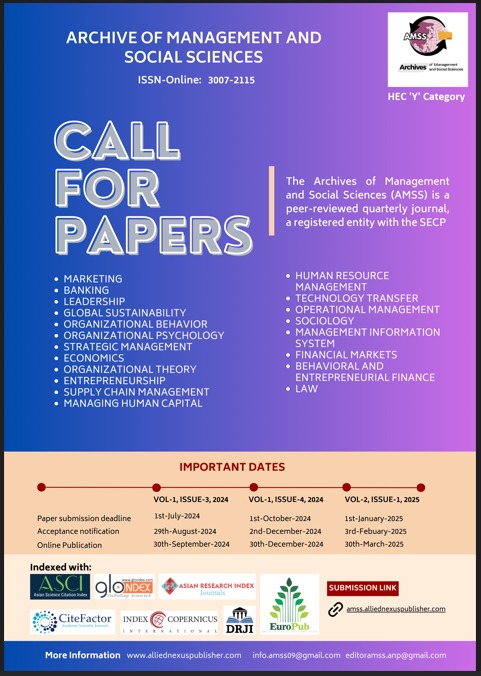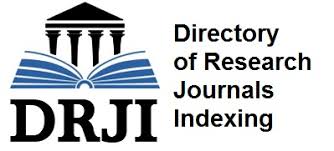Staffing And Employees Performance in Nigerian Tertiary Institutions
Keywords:
Staffing, employee performance, recruitment, selection, assessment, human resourceAbstract
The study investigated the correlation and nexus between staffing and employee performance: A Case in Olabisi Onabanjo University (OOU). Staffing deals with attracting an increase number of quality job-seekers and selecting the creme de’la crème so as to achieve competitiveness within the organisation. Resource Based View Theory and Equity Theory were adopted as framework. More so, the research employs cross section correlational method as the research design with the method of data analysis ranging from frequency analysis, factor analysis, descriptive analysis as well as multiple regression analysis. The study made use of simple random sampling technique to directly select respondents for the research. As such, a total of 374 respondents from both the academic and non-academic staff of Olabisi Onabanjo University were selected. Primary data was collected through questionnaire while secondary data was collected through review of published literature such as journals articles, published theses and textbooks. Data was analysed using Statistical Package for Social Science (SPSS) version 25.0. Findings revealed that all independent variables have a significant positive relationship with employee performance. The findings thus led the researcher to conclude that there is significant relationship between staffing and employee performance. The research thus recommended that other staffing practices not discussed in this research should be carried out in line with employee performance.
References
1. Adeyi, A. O., Apansile, E. K., Okere, W., & Okafor, L. I. (2018). Training and development and organisational performance: Standpoint from Private tertiary institutions in Nigeria. Journal of Economics, Management and Trade, 21(12), 1-10.
2. Anitha, J. (2014). Determinants of employee engagement and their impact on employee performance. International journal of productivity and performance management, 63(3), 308-323.
3. Anyalor, M., Nwali, A. C., & Agbionu, U. C. (2018). Employee engagement and performance of lecturers in Nigerian tertiary institutions. Journal of Education and Entrepreneurship, 5(2), 69-87.
4. Barney, J. (1991). Firm resources and sustained competitive advantage. Journal of management, 17(1), 99-120.
5. Barney, J. B. (2001). Resource-based theories of competitive advantage: A ten-year retrospective on the resource-based view. Journal of management, 27(6), 643-650.
6. Beltrán-Martín, I., & Bou-Llusar, J. C. (2018). Examining the intermediate role of employee abilities, motivation and opportunities to participate in the relationship between HR bundles and employee performance. BRQ Business Research Quarterly, 21(2), 99-110.
7. Dashwep, C. J. (2021). Promoting Motivation For Employee Performance: A Case of Nigeria Public Sector (Doctoral dissertation, The Open University of Tanzania).
8. Deshpande, S. P., & Golhar, D. Y. (1994). HRM practices in large and small manaufacturing firms: A comparative study. Journal of small business management, 32(2), 49.
9. Dyck, B., & Neubert, M. J. (2009). Principles of management. South-Western.
10. Ekwoaba, J. O., Ikeije, U. U., & Ufoma, N. (2015). The Impact of Recruitment and Selection Criteria on Organizational Performance.
11. Gamage, A. S. (2014). Recruitment and selection practices in manufacturing SMEs in Japan: An analysis of the link with business performance. Ruhuna Journal of Management and Finance, 1(1), 37-52.
12. Hausknecht, J. P., & Wright, P. M. (2012). Organizational strategy and staffing. The Oxford handbook of personnel assessment and selection, 147-155.
13. Henry, O., & Temtime, Z. (2010). Recruitment and selection practices in SMEs: Empirical evidence from a developing country perspective. Advances in Management.
14. Jibrin-Bida, M., Abdul-Majid, A. H., & Ismail, A. (2017). Management support as a moderator in the HR practices-employee performance relationship. International Journal of Management Research and Reviews, 7(1), 13.
15. Kim, Y., & Ployhart, R. E. (2014). The effects of staffing and training on firm productivity and profit growth before, during, and after the Great Recession. Journal of Applied Psychology, 99(3), 361.
16. Korff, J., Biemann, T., & Voelpel, S. C. (2017). Human Resource Management Systems and Work Attitudes: The Mediating Role of Future Time Perspective. Journal of Organizational Behavior, 38, 45-67.
17. Mondy, R. W., & Mondy, J. B. (2014). Human resource management. Harlow, England.
18. Mugambi, F. N., & Omuya, J. (2023). Effect of Recruitment and Selection on Employee’s Performance in Public Universities in Meru County, Kenya. Asian Journal of Economics, Business and Accounting, 23(22), 122-137.
19. Nassazi, A. (2013). Effects of training on employee performance.: Evidence from Uganda.
20. Nishii, L. H., & Leroy, H. (2022). A multi-level framework of inclusive leadership in organizations. Group & organization management, 47(4), 683-722.
21. Njine, G. W., Nzulwa, J., Kamaara, M., & Ombui, K. (2017). Influence of staffing practice on innovation performance of DTS in Kenya. Human Resource and Leadership Journal, 2(1), 1-12.
22. Odor, H. O., Martins-Emesom, J. N., & Bakwuye, C. O. (2019). Recruitment and selection practices in higher institutions of learning in Nigeria. International Journal of Research in Business Studies and Management, 6(10), 31-39.
23. Ofori, D., & Aryeetey, M. (2011). Recruitment and selection practices in small and medium enterprises: Perspectives from Ghana. International Journal of Business Administration, 2(3), 45.
24. Olufemi, A. J. (2009). An evaluation of human resource management (HRM) Practices in Nigerian universities: The impact of size. The Social Sciences, 4(5), 494-498.
25. Onwe, S. O., Abah, E. O., Nwokwu, P. M., & Paul, M. (2015). Motivation as veritable tool for effective leadership in the Nigerian Health sector. Public Policy Adm Res, 5, 1-9.
26. Pahos, N., & Galanaki, E. (2019, March). Staffing practices and employee performance: the role of age. In Evidence-based HRM: a global forum for empirical scholarship (Vol. 7, No. 1, pp. 93-112). Emerald Publishing Limited.
27. Paul, G. D., & Audu, L. S. (2019). Effects of training of academic staff on employees’ performance in federal polytechnics, Nigeria. International Journal of Engineering Technologies and Management Research, 6(9), 1-21.
28. Priyanath, H. M. S. (2006). Managerial deficiencies in the small and medium enterprises (SMEs) in Sri Lanka: An empirical evidence of SMEs in the Ratnapura District. Sabaragamuwa university journal, 6(1), 93-105.
29. Walker, H. J., Feild, H. S., Giles, W. F., Armenakis, A. A., & Bernerth, J. B. (2009). Displaying employee testimonials on recruitment web sites: effects of communication media, employee race, and job seeker race on organizational attraction and information credibility. Journal of Applied Psychology, 94(5), 1354.
30. Wright, P. M., & McMahan, G. C. (2011). Exploring human capital: putting ‘human’back into strategic human resource management. Human resource management journal, 21(2), 93-104.
Downloads
Published
Issue
Section
License
Copyright (c) 2024 Archives of Management and Social Sciences

This work is licensed under a Creative Commons Attribution 4.0 International License.









